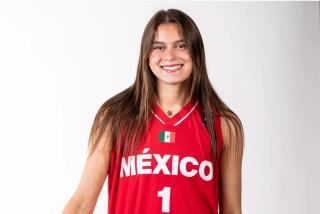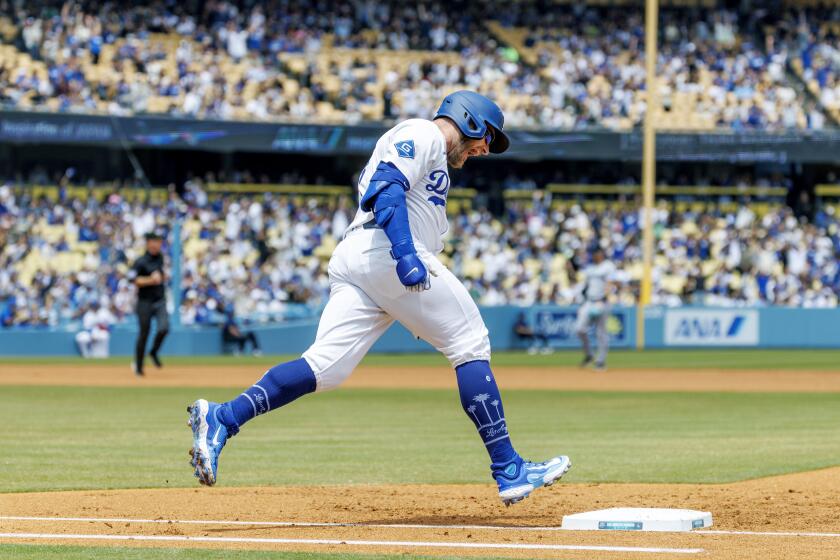Line of scrimmage crosses the border
- Share via
MEXICO CITY — Like that famous old sports saying goes, it’s not whether you win or lose, but whether your visa arrives in time to play the game. Hey, we’re not talking about the New England Patriots here. In sheer physical tonnage, Team Mexico is probably closer to the Canton Bulldogs or the Chicago Staleys, circa 1925, than the Patriots or the Philadelphia Eagles, circa 2005.
They may be closer to them in spirit as well, this band of gritty, dedicated amateurs, many of them high school and college kids, jetting off to Jacksonville, Fla., this week to butt heads with similar squads from Japan, Canada, Jacksonville and France (France?) in the NFL Global Junior Championship IX. The 36-man Mexican all-star team is scheduled to play its first game Wednesday against France (France?) on a Jacksonville high school field. The championship game takes place Saturday, the day before the Eagles and Patriots square off in Super Bowl XXXIX.
It’s all part of the artfully hyped spectacle that is Super Bowl week. It’s also part of the NFL’s grand strategy to spread the gridiron gospel of Vince Lombardi around the globe, and Mexico is regarded as prime AstroTurf for expansion. More than 100,000 Mexicans from Tijuana to Chiapas play the game known here as “futbol Americano,” says Jose Jorge Orobio, president of the Mexican Federation of American Football, a 9-year-old regulatory body that oversees all levels of competition here, from juvenile leagues to semi-professionals.
Football also rates high as a spectator sport in Mexico. Major semiprofessional and college games can pack stadiums with tens of thousands. Aside from televised major bowl games, U.S. college football doesn’t make much of a splash. But millions of Mexicans watched last year’s Super Bowl on television, and according to some surveys, American pro football is rated second in popularity only to soccer, which is practically more of a national religion than a sport. Though baseball rules in other Latin countries such as Cuba and the Dominican Republic, in Mexico U.S. pro football gets exhaustive newspaper coverage, and on any given Sunday cable and satellite viewers can gorge on as many NFL games as the average couch potato in Green Bay or Garden Grove.
Even so, football in Mexico sometimes can be a hand-to-mouth affair. Practice facilities are patchy and few. Sponsorships are minimal. The entire Mexican federation, according to Orobio, subsists on an annual budget of $75,000, probably about what the Eagles defensive line consumes in T-bone steaks during an average season.
At the end of last week, Orobio was still scrambling to line up U.S. visas for seven of his all-star players. By Saturday morning, he had the last visas (at $195 a pop) in hand and was racing off to a practice field outside Mexico City to watch the all-stars go through a light practice before they headed off to the airport the next day.
“They are going to change the global image of Mexico,” Orobio said of the team as he guided his slate-gray Chevy Suburban through Mexico City’s precarious traffic. “They are very disciplined.”
Just the previous night, Orobio said, he had fallen asleep at the wheel and accidentally struck another car. The dark half-moons under his eyes bore witness to his obsession with gringo-style football. Being federation president is a nearly full-time gig for which Orobio said he receives not a single centavo. He earns his living through his other full-time job as a certified public accountant.
“It [football] is my vice,” said Orobio, a stout, jovial man who wears a miniature gold football helmet on a chain around his neck. “I don’t smoke, I don’t drink.”
Sometimes when the federation is short on money or an emergency expense crops up, Orobio said, he pays for it with his personal credit card. Supporting American football, like many other things in Mexico, tends to be a family affair. Two of Orobio’s sons play football, and his wife loves the sport as well, he says. “If the wives don’t like it, they get separated or divorced.”
Here’s the drill
The sun was already blazing through Mexico City’s layer of perma-smog as Orobio pulled up at the practice field of the Pieles Rojos (Redskins) football club. As teams of young players sprinted through warm-up drills, and a platoon of hungry-looking stray cats prowled the parking lot, the slightly older Team Mexico members began to trickle in. Among the first arrivals was Roberto Juarez, a 6-foot, 250-pound lineman who’s majoring in business administration at a Mexican university and hopes to play semiprofessionally. Traditionally, a handful of Mexican colleges and technical schools have been the bedrock of American football here, and the sport has been played at some universities for a century.
Juarez said that his father, grandfather and uncle all played the game, and he started at age 11. In recent years, cable and satellite television have boosted American football’s popularity in Mexico, Juarez said, including that of his favorite NFL team, the Dallas Cowboys. Other fan favorites here include the Houston Texans, with a strong cross-border following, and the Denver Broncos, whose John Elway-led championship years in the late 1990s coincided with the growth of satellite and cable TV broadcasts of NFL games, Mexican football officials say.
Gerardo Marin, 19, a receiver from the state of Mexico, said he prefers American football to soccer because there’s more strategizing involved in the blocking and the martial-like offensive and defensive formations. He’d made the trip with the Mexican all stars to last year’s Global Junior Championship in Houston, where he stayed with a host family and came to admire the local customs.
“The people are very organized there,” he said. This year, he’s concerned about his idol, Eagles star receiver Terrell Owens, who’s nursing an injured leg and may miss the Super Bowl. “God willing, he’ll play,” Marin said.
If Mexican football players share certain interests and attitudes with their U.S. counterparts, they still appear to be lagging behind them in size. Gerardo Hernandez, an offensive lineman, checks in at 6 feet 8 and 355 pounds, and Javier Chavez, a defensive lineman, is a hefty 6 feet 5 and 297 pounds. But it’s normally “very, very difficult” to find big kids in Mexico, especially outside the northern cities closer to the U.S. frontera, said Marcos Guirles, an NFL scouting coordinator who had come to watch the morning’s practice.
Nonetheless, Guirles, a native of Spain who formerly coached the running backs and special teams unit of the NFL Europe’s Barcelona Dragons, believes that “Mexico has a great talent. I think the coaches are doing a great job.”
A few yards away, on the other side of a sagging chain-link fence, Team Mexico was going through its drills at about three-quarter speed. The point of the practice, several coaches said, was to keep the players feeling loose rather than tense about their upcoming trip.
Watching his players run back kickoffs, head Coach Juan Gonzalez, 33, even went so far as to suggest that maybe Grantland Rice had been right all those years ago when he said what mattered was how you played the game. “The most important thing,” Gonzalez said, “is to help form the young people to be good people, good citizens.” Then he ended the practice and sent his players off to guzzle Gatorade.
That’s not necessarily a gridiron motto that’ll win you a free trip to Disneyland, the traditional payoff to the Super Bowl’s Most Valuable Player.
But it may be plenty good enough to carry from Mexico City to Jacksonville, with or without a visa.
More to Read
Go beyond the scoreboard
Get the latest on L.A.'s teams in the daily Sports Report newsletter.
You may occasionally receive promotional content from the Los Angeles Times.











